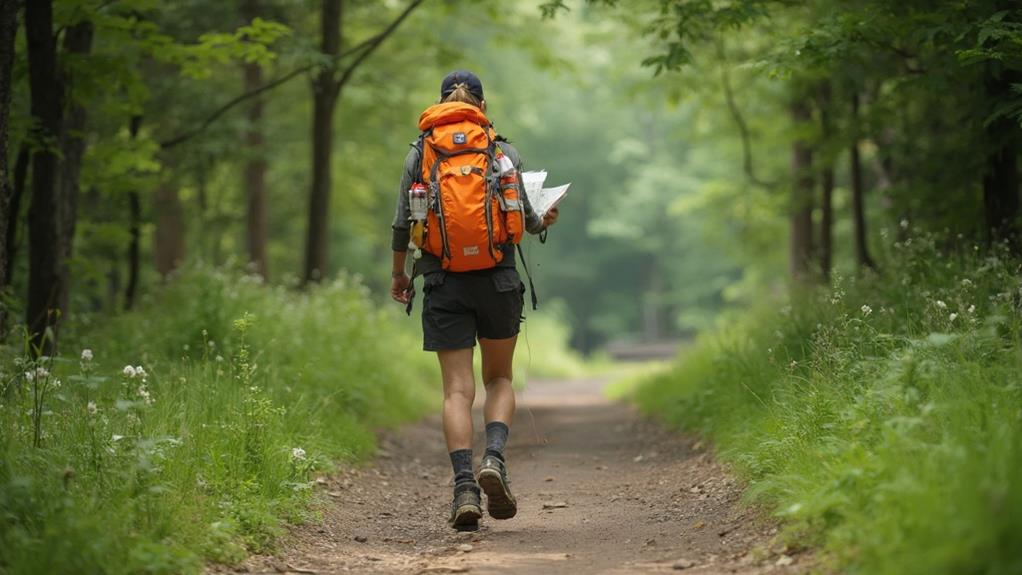Starting on your first day hike? Start by selecting a trail under 5 miles with gentle elevation to match your fitness level. Equip yourself with moisture-wicking clothing and sturdy footwear, ensuring your 20-30L daypack is ready with essentials like water and a first aid kit. Learn basic navigation; a GPS app and a physical map together enhance preparedness. Prioritize safety by informing someone about your plan while keeping an eye on the weather. Finally, respect trail etiquette—yield to uphill trekkers and keep your pet leashed. Grab these essentials, and you're poised to uncover the wonders that await on your adventure.
Key Takeaways
- Choose trails under 5 miles with minimal elevation gain for a manageable beginner hike.
- Wear moisture-wicking clothing and supportive footwear to ensure comfort and prevent blisters.
- Pack essential gear including a 20-30L daypack, water, snacks, and a first aid kit.
- Use GPS apps and carry a physical map for accurate navigation and backup.
- Inform someone of your itinerary and expected return time for safety.
Select the Right Trail
Selecting the right trail is essential for ensuring a rewarding and enjoyable first hiking experience. When initiating this adventure, trail selection and terrain evaluation are critical steps that can define the success of your journey.
For beginners, opting for trails under 5 miles with minimal elevation gain is advisable, allowing you to acclimate to the physical demands of hiking without overwhelming challenges. Resources such as AllTrails and GaiaGPS are invaluable in identifying well-marked, beginner-friendly trails that are popular among hiking enthusiasts.
Thoroughly evaluating the trail's total climbing and terrain type is significant. Flat trails offer a stark contrast in difficulty compared to steep or rocky paths, which can be intimidating for novices.
Additionally, researching the trail's accessibility based on the time of year and prevailing weather conditions helps in preparing for potential obstacles, ensuring a safer hike.
Another factor to reflect on is the travel distance to the trailhead. This will affect your overall schedule, allowing ample time for both hiking and returning, consequently contributing to a relaxed and enjoyable outing.
Gear Up Properly

When gearing up for your first day hike, preparation and the right equipment can make all the difference between an enjoyable adventure and an exhausting ordeal.
To guarantee you're well-prepared, focusing on moisture management is vital. Opt for moisture-wicking clothing made from synthetic or wool materials. These fabrics excel at keeping you dry and comfortable by drawing sweat away from your skin, unlike cotton, which retains moisture and can lead to discomfort.
Footwear selection is another important aspect. Choose trail runners or supportive hiking boots that offer a snug fit without being too tight, as this helps prevent blisters on varied terrains. Comfort is key, so take the time to find the right pair that suits your hiking needs.
Here's a quick checklist to help you gear up properly:
- Select Proper Clothing: Wear moisture-wicking garments to maintain comfort and dryness.
- Choose the Right Footwear: Invest in comfortable, well-fitted trail runners or hiking boots.
- Pack Essentials: Use a 20-30L daypack with water, snacks, layers, a first aid kit, and trekking poles.
Master Navigation Basics
Equipping yourself for a hike goes beyond the right gear; mastering navigation basics is equally important to guarantee a safe and fulfilling journey. Familiarize yourself with essential map reading skills, which include interpreting symbols, scales, and contours to assess trail information and elevation changes proficiently. This knowledge empowers you to understand your environment and anticipate challenges ahead.
In addition to map reading, employing GPS tracking with devices or apps like GaiaGPS offers real-time location information, ensuring you remain on the correct path even in the absence of cell service. However, technology can falter; therefore, carrying a physical map as a backup is essential, especially in remote areas where signal or battery failures might occur.
| Navigation Tool | Purpose |
|---|---|
| Physical Map | Backup navigation; reliable in remote areas |
| GPS Device/App | Real-time location tracking; complements map use |
| Compass | Reliable orientation; useful in poor visibility |
Moreover, practice identifying landmarks along your route to aid in orientation and provide reference points if you lose your way. Complement these skills with compass usage, which can be significant when visibility is poor or trails are ill-marked, ensuring a successful and enjoyable hiking adventure.
Prioritize Safety Measures

Guaranteeing a safe and enjoyable hiking experience begins with prioritizing safety measures that protect both your well-being and peace of mind. As you prepare for your first day hike, consider these essential safety strategies to prevent injuries and manage potential emergencies.
1. Inform Emergency Contacts: Before heading out, share your hiking itinerary with a trusted friend or family member. Include details such as the trail name, your expected return time, and any contingency plans. This vital step guarantees someone knows your whereabouts and can alert authorities if you do not return as scheduled.
2. Prepare for Injury Prevention: Equip yourself with a well-stocked first aid kit tailored for day hikes. This should include supplies for treating common trail injuries like cuts, scrapes, and blisters.
Don't forget to pack any personal medications you may require. By being prepared, you can address minor injuries promptly, preventing them from escalating into more serious issues.
3. Stay Hydrated and Informed: Hydration is key to maintaining energy levels and preventing fatigue. Bring at least one liter of water for every two hours of hiking, accounting for extra in case of unexpected delays.
Additionally, check the weather forecast and prepare for varying conditions by packing suitable clothing, such as rain gear and extra layers.
Practice Trail Etiquette
Respecting the trail and fellow hikers is fundamental to a harmonious and sustainable outdoor experience. Practicing proper trail etiquette not only enhances your hiking experience but also preserves the natural environment for future adventurers. Key aspects of trail etiquette include hiker communication and wildlife awareness, which are vital for maintaining trail harmony. Uphill hikers have the right of way; consequently, as you descend, step aside to allow them to pass safely. This simple gesture of respect guarantees a smooth journey for everyone.
When hiking with your dog, always keep it leashed and under control. This practice safeguards the wildlife and guarantees fellow hikers feel secure. Additionally, on narrow paths, give way to faster hikers by stepping aside, allowing them to maintain their pace without disruption. Announcing your presence when approaching horses or pack stock is significant in preventing startling them, guaranteeing a safe passage for all involved.
| Trail Etiquette Tips | Description |
|---|---|
| Uphill Right of Way | Descending hikers should yield to uphill hikers. |
| Leash Your Dog | Keep dogs leashed to protect wildlife and hikers. |
| Allow Faster Hikers | Step aside on narrow trails to let faster hikers pass. |
| Avoid Shortcuts | Stay on paths to preserve trail integrity. |
| Announce Presence | Alert when approaching horses or pack stock. |
Avoiding shortcuts is equally important, as it preserves the ecosystem and maintains the trail's integrity. By adhering to these guidelines, your hike will be both enjoyable and respectful to the natural world.
Frequently Asked Questions
How Do I Prepare for Days Before Hiking?
To effectively prepare days before hiking, conduct thorough trail research to match your abilities. Prioritize gear selection by testing equipment for comfort and functionality. This guarantees readiness and enhances the overall hiking experience, adapting to varied conditions.
What Do You Need for Your First Hike?
For your first hike, prioritize hiking essentials such as proper footwear to guarantee comfort and safety. Equip yourself with a moisture-wicking outfit, a daypack with water, snacks, navigation tools, a first aid kit, and weather-appropriate gear.
How to Get in Shape for a Hike?
To effectively prepare for a hike, focus on hiking workouts that include strength training and dynamic stretches. Boost stamina by engaging in low-impact cardio activities like swimming and cycling, ensuring thorough endurance and fitness for challenging terrains.
How Do I Prepare for a 2 Day Hike?
Preparing for a two-day hike requires strategic gear selection, including appropriate clothing layers and a reliable shelter. Master trail navigation by familiarizing yourself with maps and GPS devices, ensuring safety and confidence while exploring diverse terrains and elevations.
Conclusion
Beginning a first day hike necessitates thorough preparation to guarantee a rewarding and safe experience. Selecting an appropriate trail sets the foundation for the journey, while equipping oneself with essential gear enhances comfort and capability. Navigational skills are vital for maintaining direction and confidence on the trail. Prioritizing safety measures mitigates risks and guarantees well-being, and practicing trail etiquette fosters respect for nature and fellow hikers. With these strategies, the adventure promises to be both enriching and memorable.